In 1944, during the Jim Crow era in the Deep South, George Stinney Jr., a 14-year-old African-American boy, became the youngest person in the United States to be executed in the electric chair.
Stinney lived in Alcolu, South Carolina, a segregated mill town where white and black residents were separated by railroad tracks.
Stinney’s family lived in a modest company house until they were forced to leave when he was accused of killing two white girls, 11-year-old Betty June Binnicker and 7-year-old Mary Emma Thames. The girls had gone missing while riding their bicycles in search of flowers. Their bodies were found the next day in a ditch, showing signs of violent head injuries.
Despite a lack of physical evidence and a trial lasting only 10 minutes, Stinney was swiftly convicted by an all-white jury. It would take 70 years for Stinney to be posthumously exonerated.
The case of George Stinney Jr. highlights the racial injustices and systemic discrimination prevalent in the Jim Crow South, where a young black boy could be sentenced to death based on flimsy evidence and racial bias.
Dr. Bozard concluded that Binnicker and Thames had suffered wounds likely caused by a “round instrument about the size of the head of a hammer.”
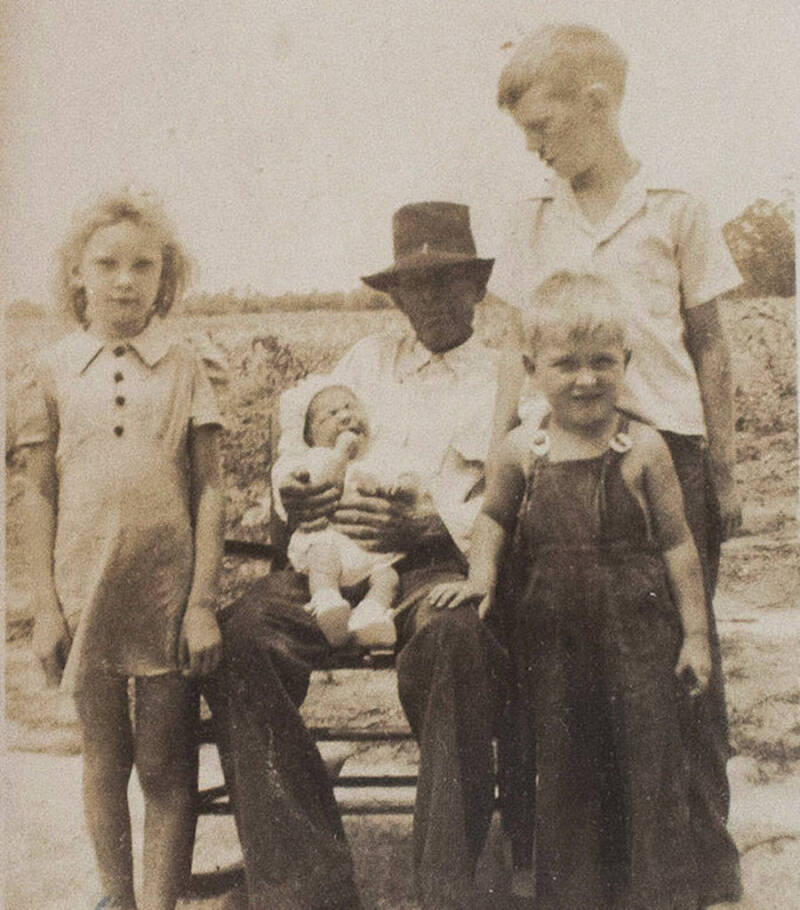
File/ReutersMary Emma Thames (left) is pictured with her family in 1943. Thames and her friend Betty June Binnicker were murdered the following year.
Despite rumors that the girls had visited a prominent white family’s home on the day of their murder, which was never confirmed, the police focused their investigation on George Stinney Jr., a young black boy. When law enforcement officers learned that the girls had been seen talking to Stinney, they promptly arrested him.
Stinney was taken into custody, handcuffed, and interrogated for hours in a small room without his parents, an attorney, or any witnesses present. The police claimed that Stinney confessed to the murders, allegedly stating that his plan to have sex with one of the girls had failed.
An officer named H.S. Newman wrote in a handwritten statement, “I arrested a boy by the name of George Stinney. He then made a confession and told me where to find a piece of iron about 15 inches long. He said he put it in a ditch about six feet from the bicycle.”
Newman refused to disclose Stinney’s whereabouts as rumors of lynching circulated in the town. Even Stinney’s parents were unaware of his location as his trial rapidly approached. In those days, 14 was deemed the age of responsibility, and Stinney was held accountable for the murder.
A Two-Hour Trial
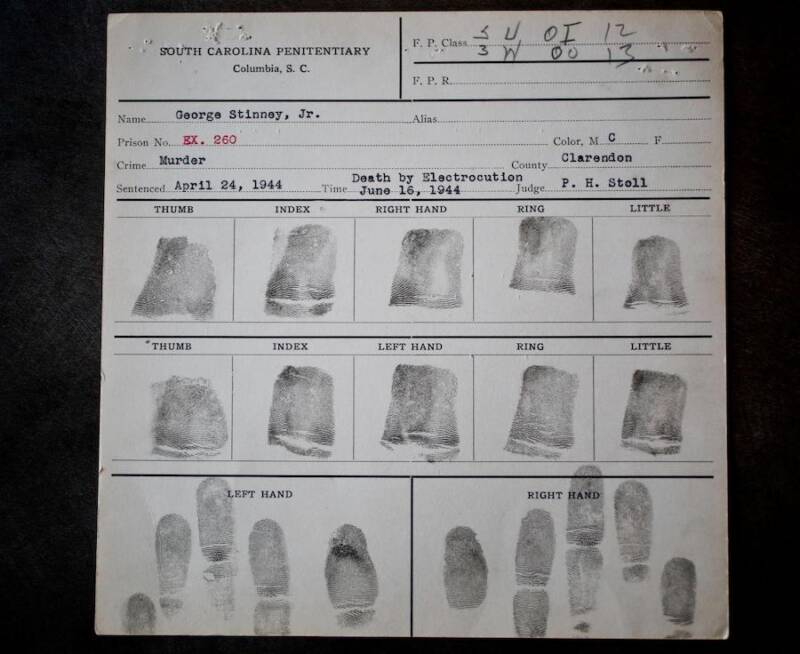
South Carolina Department of Archives and HistoryGeorge Stinney Jr.’s fingerprints are pictured on this certificate.
About a month after the girls’ deaths, George Stinney Jr.’s trial began at a Clarendon County Courthouse. Court-appointed attorney Charles Plowden did “little to nothing” to defend his client.
During the brief two-hour trial, Plowden neglected to call witnesses or present evidence that could have challenged the prosecution’s case. The key evidence against Stinney was his alleged confession, but there was no written record of this confession.
At the time of his trial, Stinney had not seen his parents for weeks. They were too afraid of being attacked by a white mob to attend the court proceedings. As a result, the 14-year-old was surrounded by strangers, estimated to be up to 1,500 people.
After a deliberation that lasted less than 10 minutes, the all-white jury found Stinney guilty of murder, without recommending mercy.
On April 24, 1944, the 14-year-old was sentenced to death by electrocution.
The Execution Of George Stinney Jr.
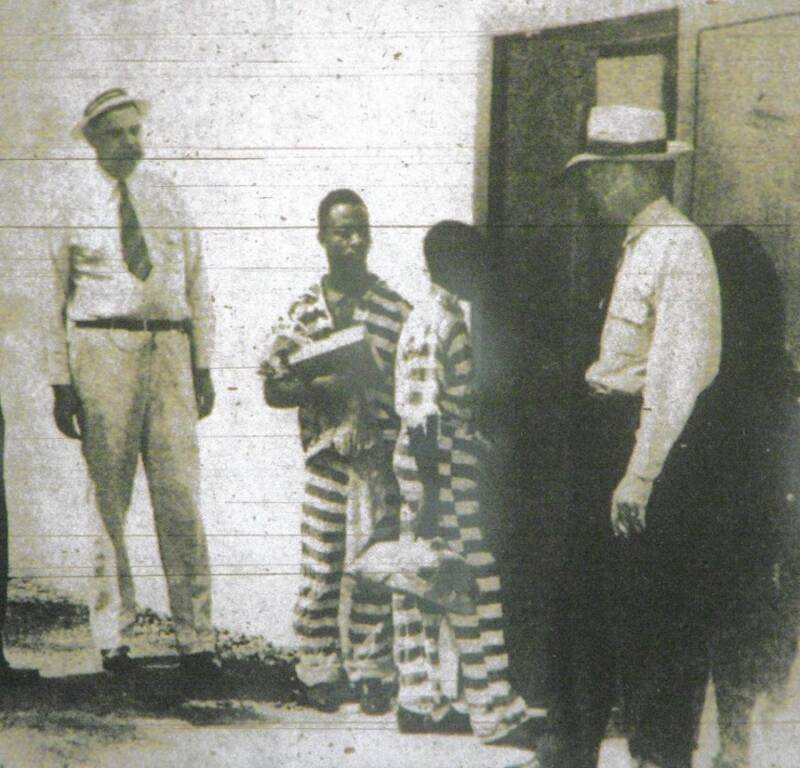
Jimmy Price/Columbia RecordGeorge Stinney Jr. (second from right) was likely coerced into confessing to the murder of two girls.
Despite protests and appeals for clemency from both white and black ministerial unions, as well as hundreds of letters and telegrams, Governor Olin Johnston did not grant George Stinney Jr. clemency based on his young age.
On June 16, 1944, Stinney walked into the execution chamber at the South Carolina State Penitentiary in Columbia with a Bible under his arm. Weighing just 95 pounds, he was dressed in a loose-fitting striped jumpsuit.
Strapped into an adult-size electric chair, he was so small that the state electrician had difficulty adjusting an electrode to his right leg. A mask too big for him was placed over his face.
An assistant captain asked Stinney if he had any last words. Stinney replied, “No sir.” The prison doctor prodded, “You don’t want to say anything about what you did?” Again, Stinney replied, “No sir.”
When officials activated the switch, 2,400 volts surged through Stinney’s body, causing the mask to slip off. His eyes were wide and teary, and saliva was emanating from his mouth for all the witnesses in the room to see. After two more jolts of electricity, it was over.
Stinney was pronounced dead shortly thereafter. In a span of just 83 days, the boy had been charged with murder, tried, convicted, and executed by the state.
A Murder Conviction Overturned 70 Years Later
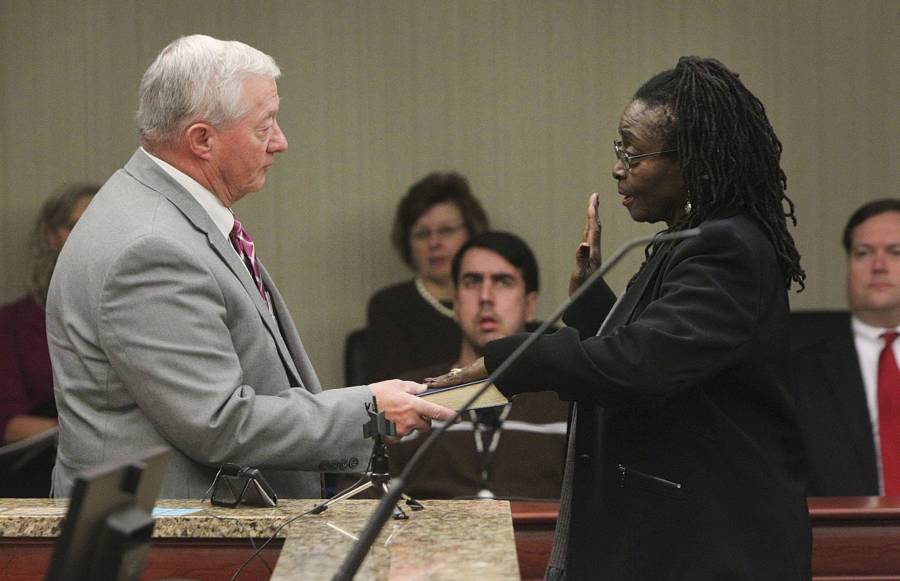
In 2014, George Stinney’s murder conviction was overturned. His siblings asserted that his confession had been coerced and that he had an alibi: he was with his sister Aime, watching the family’s cow, at the time of the murders.
They also cited testimony from Wilford “Johnny” Hunter, who claimed to be Stinney’s cellmate and said that Stinney had denied killing Binnicker and Thames.
“He said, ‘Johnny, I didn’t, didn’t do it,’” Hunter said. “He said, ‘Why would they kill me for something I didn’t do?’”
After months of consideration, on December 17, 2014, Judge Carmen T. Mullen vacated the murder conviction, calling George Stinney Jr.’s death sentence a “great and fundamental injustice.”
George Stinney Jr.’s siblings were overjoyed to learn of their brother’s exoneration after 70 years, grateful that they had lived long enough to witness this momentous event.
“It was like a cloud just moved away,” said Stinney’s sister, Katherine Robinson. “When we got the news, we were sitting with friends… I threw my hands up and said, ‘Thank you, Jesus!’ Someone had to be listening. It’s what we wanted for all these years.”

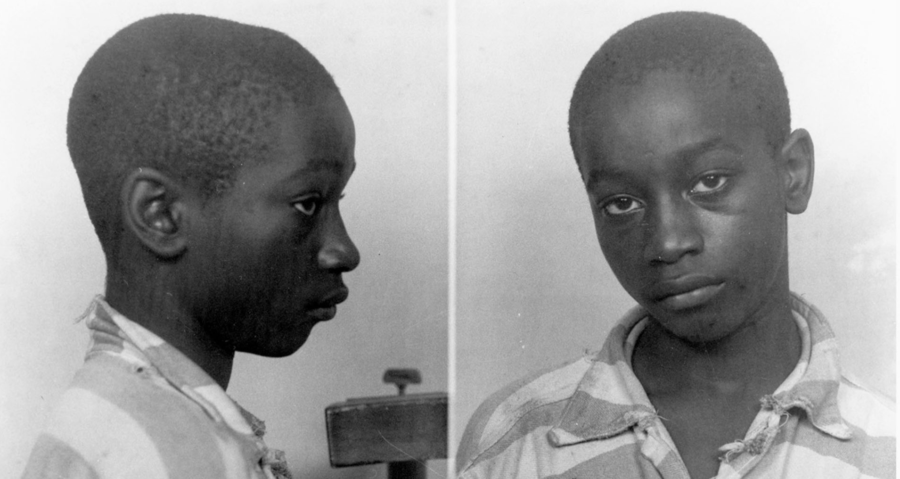
Very soon this web site will be famous amid all blogging and site-building users, due to it’s pleasant articles or reviews
Hi, the whole thing is going nicely here and ofcourse every one is sharing data, that’s truly good,
keep up writing.
Quality posts is the key to attract the users to pay a visit the web page, that’s what this web page is providing.
I always spent my half an hour to read this web site’s articles or reviews every day along
with a cup of coffee.
Hello there, You’ve done a fantastic job. I’ll certainly digg it and personally recommend to my friends.
I am sure they’ll be benefited from this website.
I am regular visitor, how are you everybody?
This article posted at this site is genuinely nice.
Wonderful, what a webpage it is! This weblog gives useful data to us, keep it up.
For most up-to-date information you have to visit world wide web and on the web
I found this web site as a best web site for most recent updates.
What’s up, this weekend is good in support of me, for
the reason that this point in time i am reading this great educational post here at my house.
certainly like your web site however you have to test the spelling on quite
a few of your posts. Several of them are rife with spelling issues and I to find it very bothersome to
inform the truth however I will surely come back again.
I’m not positive the place you’re getting your info, however
great topic. I must spend a while learning more or working out more.
Thanks for magnificent info I was looking for this information for my mission.
Hmm is anyone else encountering problems with the images on this blog loading?
I’m trying to find out if its a problem on my end or if it’s the blog.
Any feedback would be greatly appreciated.
Good web site you have here.. It’s hard to find quality writing like yours
these days. I really appreciate individuals like you!
Take care!!
I every time spent my half an hour to read this blog’s content everyday along with a mug of
coffee.
I think this is among the most significant information for me.
And i am glad reading your article. But want to remark on some general things, The site style is wonderful, the
articles is really excellent : D. Good job, cheers
Hey there are using WordPress for your site platform?
I’m new to the blog world but I’m trying to get started and set up my own. Do you require
any html coding expertise to make your own blog?
Any help would be really appreciated!
Hello there, I discovered your blog by means of Google whilst looking
for a related matter, your web site came up,
it appears great. I have bookmarked it in my google bookmarks.
Hello there, simply was aware of your weblog through Google, and found that it’s really informative.
I am going to be careful for brussels. I will be grateful in case you
proceed this in future. Many other folks will probably be benefited from your writing.
Cheers!